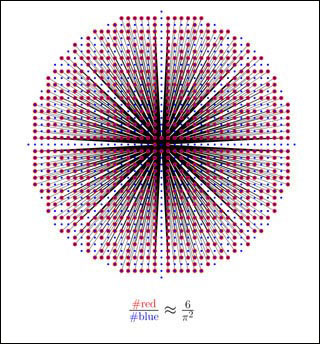Here's working definiitiondefinition from What is... an Approximate Group? Let $A$ be a subset of a group with $A^{-1}=A$ then $A$ is an $K$-approximate group if $A^2$ is covered by a certain number $K$ of translates of $A$.
These are not even subgroups or cosets.
- Arithmetic sequences $ \{\sum n_i x_i : |n_i| < N_i \} $ is a $2^d$ approximate group. It's not even closed under addition, it just kind of overlaps with itself.
- $S = \{\left( \begin{array}{ccc} 1 & a & b \\ 0 & 1 & c \\ 0 & 0 & 1 \end{array} \right) \text{ with }|a|, |c| \leq N \text{ and }|b| \leq N^2\}$ is an 100-subgroup if add it's inverses $A = S \cup S^{-1}$.
It's not hard to come up with your own definition of approximate symmetry how about:
$$ A = \{ (a,b): \mathrm{gcd}(a,b) = 1 \text{ and } |a| ,|b| \leq N \} \subseteq \mathbb{Z}^2$$ and now rotate by an angle $a + bi \mapsto e^{i\theta}(a + bi)$. This set has no interectionintersection with itself. Yet say the pairs of numbers $(a,b)$ which are relatively prime should be a rotationally symmetric set approximately --- and this might not even fall under Tao/Green/Breullard's definition.
The Structure of Approximate Groups outlines the types of almost-symmetry the have in mind:
A fair proportion of the subject of additive combinatorics is concerned with approximate analogues of exact algebraic properties, and the extent to which they resemble those algebraic properties. In this paper we are concerned with sets that are approximately closed under multiplication, which we do not necessarily assume to be commutative, and more specifically with approximate groups
In Almost Flat Structures Gromov is discussing differential geometry. A pseudogroup is
- A set $\Gamma$ with a binary operation (that only works for some pairs) $a b$
- unique identity element $e$ and unique inverse $a^{-1}$
- $(ab)c = a(bc)$ (associativity)
In fact Gromov gives examples of his pseudogroupseudogroup concept
- any symmetric subset $A \subseteq S_n$ containing the identity element $e \in A$ and $A = A^{-1}$
- his "local fundamental group" example places restrictions on his fundamental group so that the product is not always defined -- and he gave this structure a name.
These are closed under multiplication (when a multiplication exists) , while Approximate groups are definitely not closed. Therefore, Gromov's definition is closer to that of groupoid and there is indeed something called the fundamental groupoid whose elements are paths and not loops.
To conclude there is no relation, but there are a few ways out:
Cayley's Theorem shows every abstract group $G$ can be represented as permutations of a set. Even infinite groups like $(\mathbb{R}, +)$.
In GemetricGeometric Group Theory groups are thought of as fundamental groups of interesting spaces, such as trees or surfaces or 3-manifolds, or spaces which are not manifolds at all.

